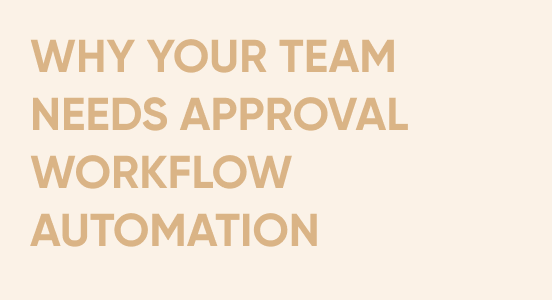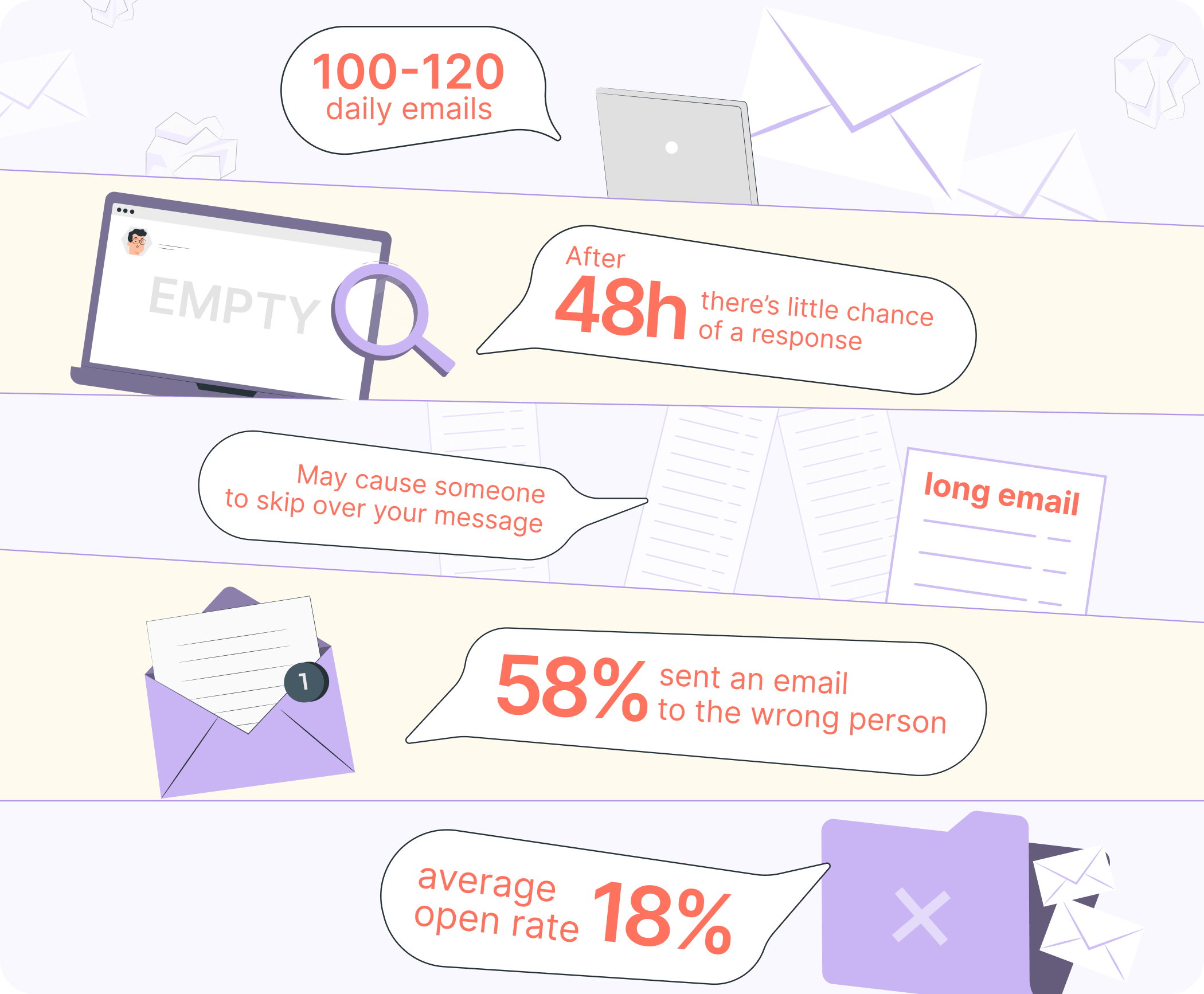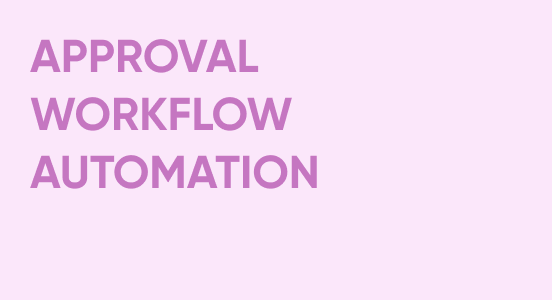
5 Steps to Turn the Approval Process via Email from a Headache into a Smooth Workflow
- Approval automation
- 9 min read
In this article, we’d like to talk to you about the approval process via email.
In the intricate web of modern business, decisions are the lifeblood that keeps the organization thriving and growing. The approval process plays a pivotal role in this, as it determines whether a project, proposal, or idea gets the green light or meets a dead-end.
Email, a ubiquitous tool in today’s corporate landscape, has become the preferred channel for these crucial approvals. But are we making the most of this digital medium? In this article, we’ll explore the approval process via email, from start to finish, shedding light on its impact, challenges, and the potential for automation to transform it into a lean, efficient workflow.

Email approval process and its issues
What can be the subject of an approval request?
- Expenses
- Documents
- Bills, contracts, invoices, purchase orders
- Time off for your employees
- New vendors to collaborate with
- Marketing campaigns
- Social media posts
- Access requests (to a certain database or room)
- Meeting room reservations
This list really is endless, and often the answer is required RIGHT NOW.
But we all know how it works, right? You send an email to whoever is responsible for what you want approved and wait for… minutes, hours, days?
Facts that will 100% discourage you from managing your approvals in your email without automation:
- The average person receives around 100-120 emails daily, not counting spam…
- After 48 hours, there’s little chance of a response. There’s a 90% likelihood that you’ll get a response within a day or two if the recipient is going to reply. (USC Viterbi School of Engineering research)
- Writing long emails may cause someone to skim over your message. And if it feels too cumbersome to read and reply, you may not get a response at all. (USC Viterbi School of Engineering research)
- Over half (58%) of employees say they’ve sent an email to the wrong person. (Tessian research)
- The average open rate for all industries is 18%. (Campaign Monitor, 2021)

So, getting a prompt response to your approval request becomes a matter of luck.
Roughly about 120 incoming emails a day: system emails, marketing spam, automatic messages from random websites…
Have you noticed how quickly your brain learns to filter them out? You end up barely looking at your inbox to know exactly which ones to open and which ones go straight to trash. But sometimes we delete things by accident. Or just miss one or two messages out of 120.

All those things combined give your approval request a pretty low chance of being seen. Now, let’s add one more human factor here. If you’re working for a small company with, for example, ten-eleven employees, that problem probably does not touch you.
But what if it’s a 100+ employees business? One just might send a request to a WRONG PERSON. That’s completely normal: people can’t possibly know what each and every human in your company is responsible for, but you’re still losing money.
One can also simply forget to mention some details that are crucial for approval of this request. And then this wonderful emailing back and forth happens. And we’re back to 120 emails a day…
The most expensive thing for a business is always human hours. Instead of using them efficiently for the benefit of the company, your employee is getting blocked by a pending approval request and is just sitting there scrolling the news feed with a sad face. It’s a constant source of stress for your workers, it heavily influences their satisfaction with their job.
To turn your approval process into a smooth stress-free workflow, you will have to make some changes in the way you approach it.

The first thing that comes to mind is to directly address the existing issues. So, our five steps will be contingent on the most often occurring troubles a typical approval process creates.
Obviously, the best and finest solution would be to get approval automation software. The market offers some great solutions and you can easily find one that fits your goals, Approveit being the most versatile and easy to implement.
Making it work perfectly without automation apps will be tricky. But we’re going to tip you off in the right direction if that’s what you choose to do.
5 steps to build a smooth and transparent approval workflow:
1. The issue: Wrong approver.
The solution:
Make it clear to your teammates who are the approvers in your workflows, and what their areas of responsibility are. That will ensure requests always get to the right person or worst case, get redirected to the right person if the mistake occurs.
How to achieve without an automation app:
Develop a guideline on writing approval request emails and spread it among your teammates. Include in it the list of the designated approvers and their areas of responsibility.
2. The issue: Approval requests are scattered all over your inbox and often get overlooked.
The solution:
Keep all approval requests in one place: limited to ONE communication channel, properly stored and logged.
How to achieve without an automation app:
Issue a memo that restricts approval requests to a single communication channel (for example, email). Requests submitted via any other communication channel CAN NOT be processed.
3. The issue: Approval requests with insufficient information.
The solution:
Make sure the approval requests have all the information necessary to make a decision by communicating to your team what data has to be included. Do not allow submitting the request unless all the required information has been provided
How to achieve without an automation app:
In this case, emailing back and forth is, unfortunately, unavoidable. If any data are missing from the email, the approver will have to request them by answering the message. Make sure those emails are joined into a chain.
4. The issue: Forgotten requests.
The solution:
Remind the approvers about pending requests. Send reminders as often as the priority and urgency of the approval request requires.
How to achieve without an automation app:
Requestors will have to make the reminders manually, there’s no other efficient way that does not involve automation apps.
5. The issue: No tracking or accountability whatsoever in the approval process.
The solution:
Make the approval process transparent, so that everyone can track the progress of requests. All additional information, comments, and discussions that happened after the request was submitted for approval need to be attached to the request and stored together with it.
How to achieve without an automation app:
Create a Google sheet where all requests will be copied upon completion by a responsible team member. This sheet will play the part of approval history.
Make a separate tab for each department. If the request contained file attachments, add links to them to the logs. Attach screenshots of the approval/rejection email to the history to avoid any misunderstandings.
That doesn’t sound so easy…
You’ll find it hard to do it all manually: it won’t save you much time or money, on the contrary, your teammates will have tasks added to their workload. Very routine tasks, too. While email-based approval workflows can be plagued by bottlenecks and inefficiencies, automation offers a way out of this quagmire.
Here are some significant benefits that automation brings to the table:
- Speed and Efficiency: Automation streamlines the entire approval process, reducing response times and eliminating bottlenecks. It ensures that approvals are routed to the right individuals automatically, speeding up decision-making.
- Accuracy and Accountability: Automated systems provide a clear audit trail, ensuring that each step of the approval process is documented and traceable. This fosters accountability among employees and reduces the risk of errors or fraud.
- Notifications and Reminders: Send automatic notifications and reminders to approvers, ensuring that approval requests are not lost in their inboxes and that responses are received promptly.
- Analytics and Insights: Automated approval workflows generate valuable data that can be used for process improvement. Businesses can identify patterns, track performance, and make data-driven decisions to optimize their approval processes further.
- Cost Savings: By reducing manual administrative tasks and minimizing delays, automation can lead to significant cost savings for businesses. It frees up employee time and resources that can be redirected toward more strategic activities.
There are plenty of workflow automation apps you can use; the most important thing is that the app you choose has all the features you need to resolve your approval process issues.
You can manage your approval process via email, or take it to any other day-to-day communication channel your team uses (like Slack).
Setting up an automated approval workflow takes only a couple of minutes, and you only have to do it once.
Moreover, new approval solutions on the market offer many additional features you might find useful!
Approveit, for example:
- Allows you to import your organizational structure, so you can assign approvers based on their role in the company;
- Works right from Slack in case you decide to move your approvals away from email;
- Offers Integrations to automate your post-approval actions;
- Lets you add multiple approval steps and trigger some of them only when a certain condition is met;
- Records approval history that you can download in .csv or .xlxs at any point;
- Lets you create and assign tasks in case an action is required after the request is approved.
Here’s what one of Approveit clients has achieved:
“We had rough estimations for how the approval processes should speed up, but real numbers exceed all our expectations. Expense approval request processing has sped up by 80%. By freeing up so many collective hours we save ~ 300K$ annually. I’m genuinely impressed, especially considering that we’ve spent about 15 minutes total to set it up. Recommended!”
Leo Yanchuk, President at Clearview
Give it a go! Who knows, maybe you’ll also end up saving 300K$ annually.
Enjoyed the reading?
Subscribe to our fresh artiles, product updates and news

